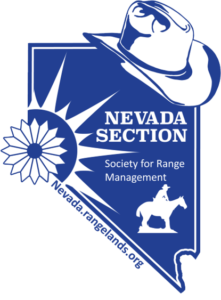 Historically, wildfires in the northern Great Basin big sagebrush plant communities experienced wildfire intervals of every 60-110 years and mostly occurred in the late summer after the perennial grasses had flowered and dried out. The accidental introduction of cheatgrass and its subsequent invasion onto millions of acres of Great Basin rangelands has increased this wildfire interval to as little as 5-10 years as reported.
Historically, wildfires in the northern Great Basin big sagebrush plant communities experienced wildfire intervals of every 60-110 years and mostly occurred in the late summer after the perennial grasses had flowered and dried out. The accidental introduction of cheatgrass and its subsequent invasion onto millions of acres of Great Basin rangelands has increased this wildfire interval to as little as 5-10 years as reported.
When habitats are threatened by this frequency of wildfires, critical wildlife habitats and sustainable grazing practices are severely threatened as well. Aldo Leopold, in 1949 recognized this problem and how impossible it is going to be to protect wildlife habitat from cheatgrass fueled wildfires.
The accidental introduction and subsequent invasion of cheatgrass indeed contributed significantly to the transformation of millions of acres of wildlife habitats throughout the West, especially shrub obligated species such as sage grouse and mule deer. Cheatgrass outcompetes native plant seedlings for limited moisture and nutrients resulting in less perennial species recruitment and more cheatgrass which provides a fine-textured, early maturing fuel that increases the chance, rate, spread and season of wildfire.
With each passing wildfire season more and more critical shrub communities are burned and converted to cheatgrass dominance. When cheatgrass invades, the likelihood of wildfires permanently removing crucial forage and cover (e.g. sagebrush, bitterbrush) for wildlife follows. This scenario has played out all across the Intermountain West, which now is experiencing larger and more frequent wildfires at alarming rates.
An excellent example of such catastrophic wildfires is the 2018 Martin Fire that burned 435,000 acres of rangelands significantly impacting grazing and wildlife resources as well as threatening life and destroying property and rangeland infrastructure (Fig. 1).
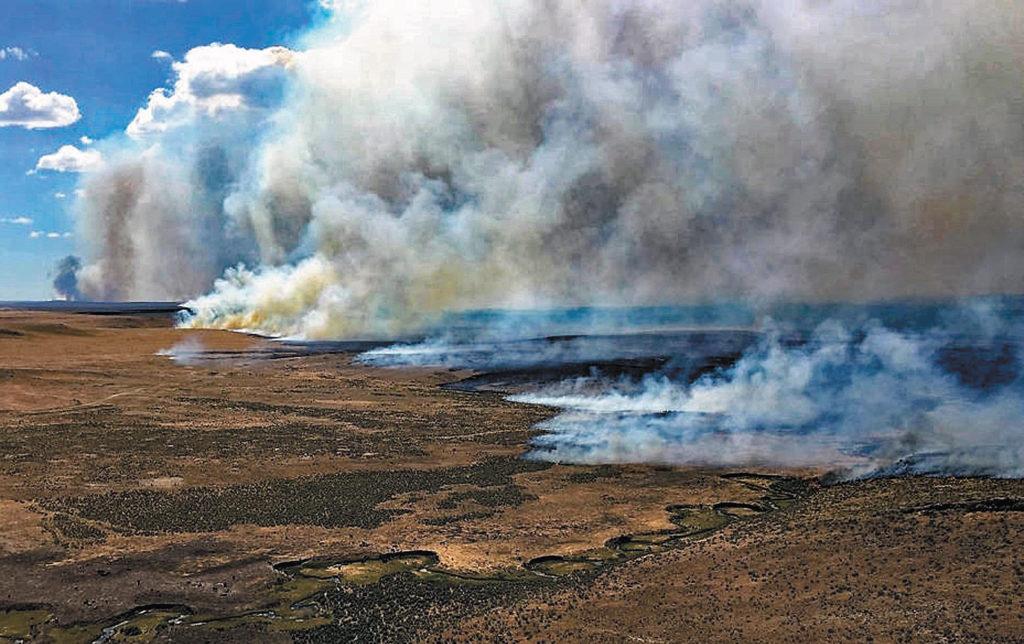
Figure 1. The Martin Fire of 2018 swept across the landscape burning critical wildlife habitats and grazing resources as well as threatening life and property and destroying critical rangeland infrastructure. (Photo courtesy of BLM)
To date, the Martin Fire is the largest recorded wildfire in Nevada state history. A number of wildlife species rely on numerous critical habitats damaged in the Martin Fire, including sage-grouse, mule deer, bighorn sheep and elk.
Management intervention is required to break the cheatgrass-wildfire cycle for recovery of habitat quality for the numerous wildlife species affected as well as grazing resources. The best-known method at suppressing cheatgrass and associated fuels is through the establishment of deep-rooted perennial grasses.
A massive collaborative effort took place between the U.S. Government, State Agencies, private business and non-government organizations which included the Bureau of Land Management (BLM), USDA-Agricultural Research Service (ARS), Nevada Department of Wildlife (NDOW) as well as wildlife and conservation organizations which included Nevada Bighorns Unlimited, Nevada Chukar Foundation, Nevada Muleys, Carson Valley Chukar Club and Nevada Gold Mines.
In the process of applying seeding treatments, the Government experienced a shutdown, temporarily halting the BLM’s efforts, but due to the strong partnership with NDOW and the BLM, NDOW did an excellent job and played a major role in seeing this massive seeding effort through without delay.
Of the 435,000 acres that burned, this collaborative effort seeded over 70,000 acres in late 2018 and early 2019 and treated another 65,000 acres with pre-emergent herbicides in 2018 to control cheatgrass and followed up with more seeding applications in 2019. The goal of this restoration/rehabilitation effort was to enhance food and cover resources for wildlife and livestock. Efforts aimed to restore/rehabilitate rangelands to an improved state for wildlife and sustainable grazing practices by establishing a high density of native and introduced perennial grasses to suppress cheatgrass and associated fuels. Cheatgrass dominated habitats were treated with pre-emergent herbicides as an aggressive and effective weed control program followed by the seeding of perennial grasses, shrubs and forbs.
There was also a goal to monitor these treated habitats to gauge the success of treatments. A number of seed mixes were aerially applied (Table 1) to more than 57,000 acres which included native and introduced grasses, shrubs and forbs. Aerial seeding is often required due to inaccessible and/or rough terrain not suitable for equipment needed in drill seeding operations.

Drill seeding operations took place under wet, muddy, and frozen as well as dry conditions which resulted in a number of issues when trying to seed at proper seeding depths and reducing soil disturbances. Seed mixes used in the drill seeding treatments (Table 2) were applied to another 5,987 acres, with another 7,614 acres of greenstip mix of Siberian wheatgrass and ‘Immigrant’ forage kochia seeded to reduce wildfire threats along roadsides.

In addition to the seeding projects, there was also another 65,217 acres that were treated with the pre-emergent herbicide, Imazapic (trade name Plateau). Plateau was applied at a 6 oz/per acre rate with 3 gallons of water per acre for optimal efficacy. This formula also allowed contractors to haul more water in a single day covering more acreage.
Herbicide treated areas were monitored the following spring and summer to measure the efficacy of the herbicide application efforts on cheatgrass control. Measurements recorded significant reductions in above ground cheatgrass densities which resulted in a significant reduction in cheatgrass seed bank densities. Areas treated with herbicide in 2018 received aerial seeding applications in the fall of 2019 with a mixture of native and introduced grasses, shrubs and forbs.
Through the monitoring stages, treatments were given a rating of 1-10 (poor – excellent), with the highest score, 10, being reported in the aerially applied Elko Seed Mix #1, followed by the drill seeded Greenstrip Seed Mix, 9, aerially applied Winnemucca Seed Mix #2 rated at 8, and the drill seeded Winnemucca Seed Mix #1 rated at 7. The other seed mixes rated in the medium success range, and though the aerial application of Wyoming big sagebrush and Western yarrow experienced very good success (Fig. 2), the aerial application of perennial grasses experienced low to medium success. Drill seeding of perennial grasses provided much more success as was anticipated (Fig. 3). “Immigrant’ forage kochia experienced very good success in the Greenstrip Mix, while ‘Immigrant’ and ‘Snowstorm’ forage kochia success was more variable throughout the treated areas. In addition to these seeding treatments, many of the habitats experienced good release of residual perennial grass species including squirreltail, Thurber’s needlegrass and Sandberg’s bluegrass.
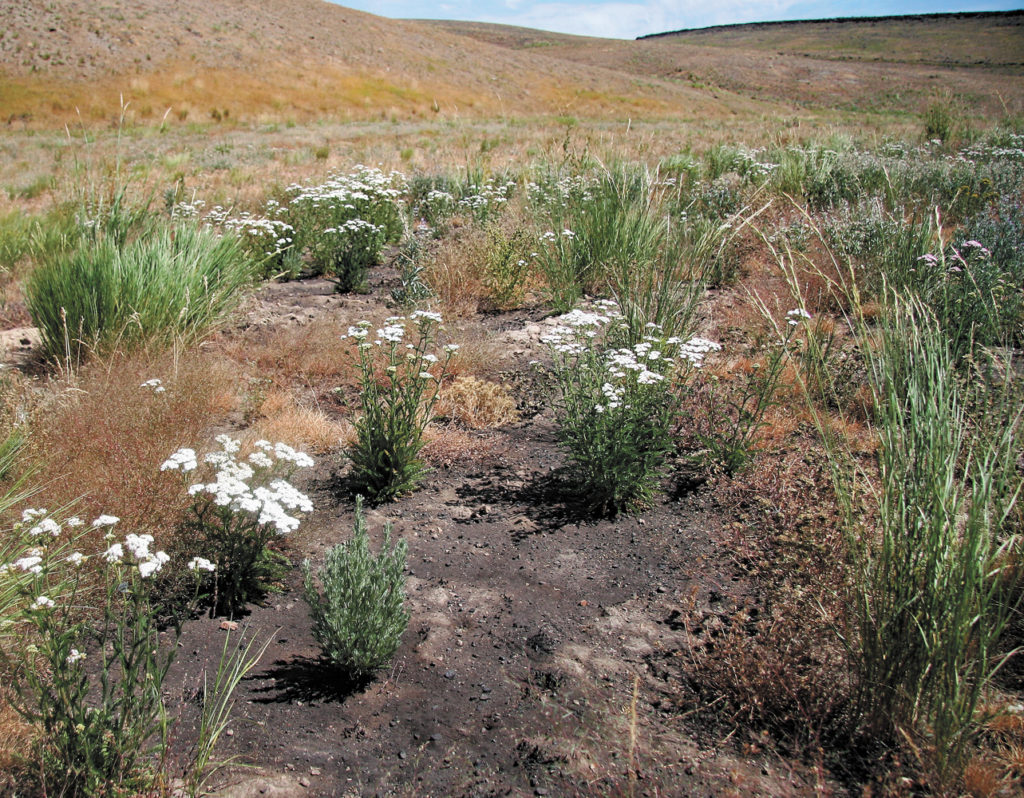
Figure 2 (top) Application of heavy rate of Wyoming big sagebrush, Western yarrow and Siberian wheatgrass in pre-selected strips resulted in excellent establishment of seeded species.
Figure 3 (bottom) Drill seeding of perennial grasses increased perennial grass density nearly 4-fold. Unseeded area (right) with residual grass density compared to seeded area (left).
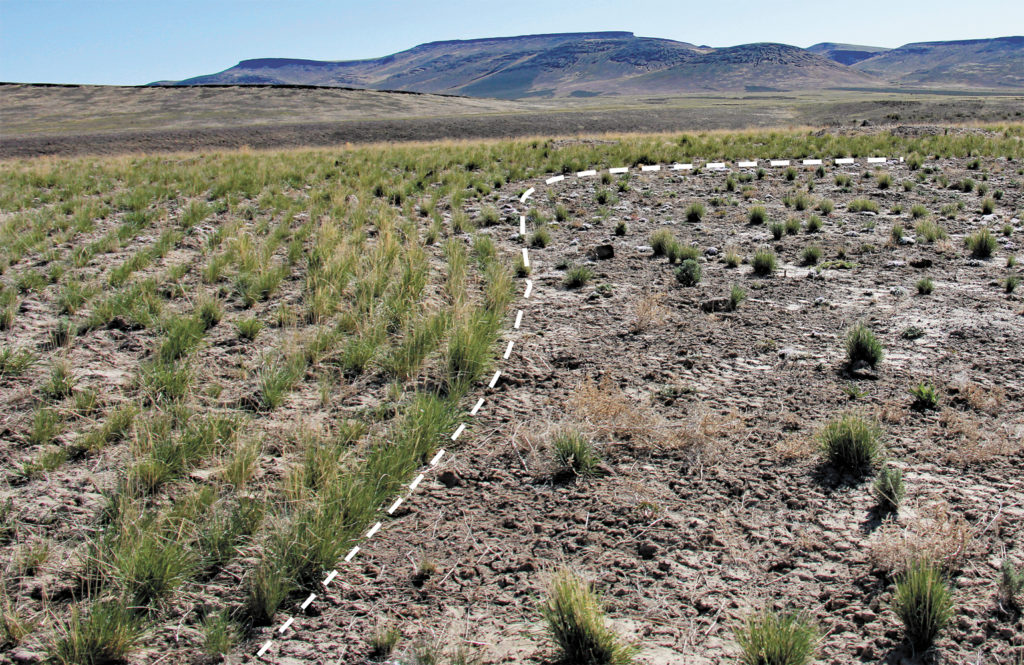
One of the most successful attributes of the efforts put forth to restore or rehabilitate rangelands burned in the Martin Fire is partnerships. Partnerships provide an opportunity to combine and stretch resources further than individual efforts. Furthermore, partnerships create a more durable environment and are an important element for successful restoration or rehabilitation of rangelands. Specifically, when the BLM was furloughed due to the Government shutdown, the partnership with NDOW allowed for the seeding of nearly 19,000 acres in the Winnemucca District during that shutdown period. Additionally, partnerships with ARS and their decades of plant material/seed mix testing and cheatgrass control research using pre-emergent herbicides shed light on the best plant species and seed mixes to use to increase success and decrease costs.
In addition to these partnerships, implementing several different treatment options can gain knowledge for future restoration or rehabilitation practices following wildfires. Throughout the efforts put forth on the Martin Fire, all involved parties agree that moving forward, incorporating more fire-resistant seed mixes around roads and infrastructure will help ensure future protection from wildfires.
The extensive mapping of critical wildlife habitats helped with identifying areas to use best practice seed mixes using species such as Wyoming big sagebrush and western yarrow and when its best to utilize forage kochia in seed mixes. The focus of these species for cover and forage will be beneficial for decades in the absence of wildfire, especially ‘Immigrant’ and ‘Snowstorm’ forage kochia which have many attributes to establish in arid environments as well as resprout following wildfire (Fig. 4).

Figure 4. The utilization of forage kochia species seeded on disturbed rangelands can provide much needed nutritional value on arid rangelands for various browsers as well as domestic livestock. ‘Snowstorm’ forage kochia (green plants) the first year after seeding.
Overall, the use of the pre-emergent herbicide, Plateau, is considered a successful tool in controlling cheatgrass and reducing cheatgrass competition in order to improve seeded species establishment. Establishing a high density of deep-rooted perennial grasses can lead to long-term suppression of cheatgrass.
The various seeding success rates can partially be attributed to seeding at different times which ran some applications into the spring of 2019 or seeding in muddy or frozen ground which reduced proper seed placement and establishment densities.
Although seeding large acreages as was done in the Martin Fire has its challenges, it is best to seed in the fall and early winter compared to late winter and spring months when temperature and moisture soil conditions are less favorable. Furthermore, getting the seed on or in the soil prior to winter allows for stratification, increased germination and earlier emergence of seeded species which contributes to a longer seedling root growth period before dry summer months.
By understanding that there was a seed shortage of certain species, utilizing the method of seeding Wyoming big sagebrush and Western yarrow at heavier rates, 1.0 and 0.10 lbs/acre, respectfully, on every third arial broadcast pass compared to seeding at the lower rate of 0.33 and 0.03 lbs/acre rates, respectfully, resulted excellent recruitment of these two species (Fig 2 above). Although budgets and the cost of a higher seeding rate may lead to seeding less acres, it is more beneficial to be successful on 500 acres than fail on 1,000 acres. Reducing the number of species in a seed mix allows those species that have the inherent potential to germinate, emerge and establish in these environments to be seeded at recommended seeding rates rather than decreasing their rates to accommodate for species that struggle to experience success (Fig. 5a and b).
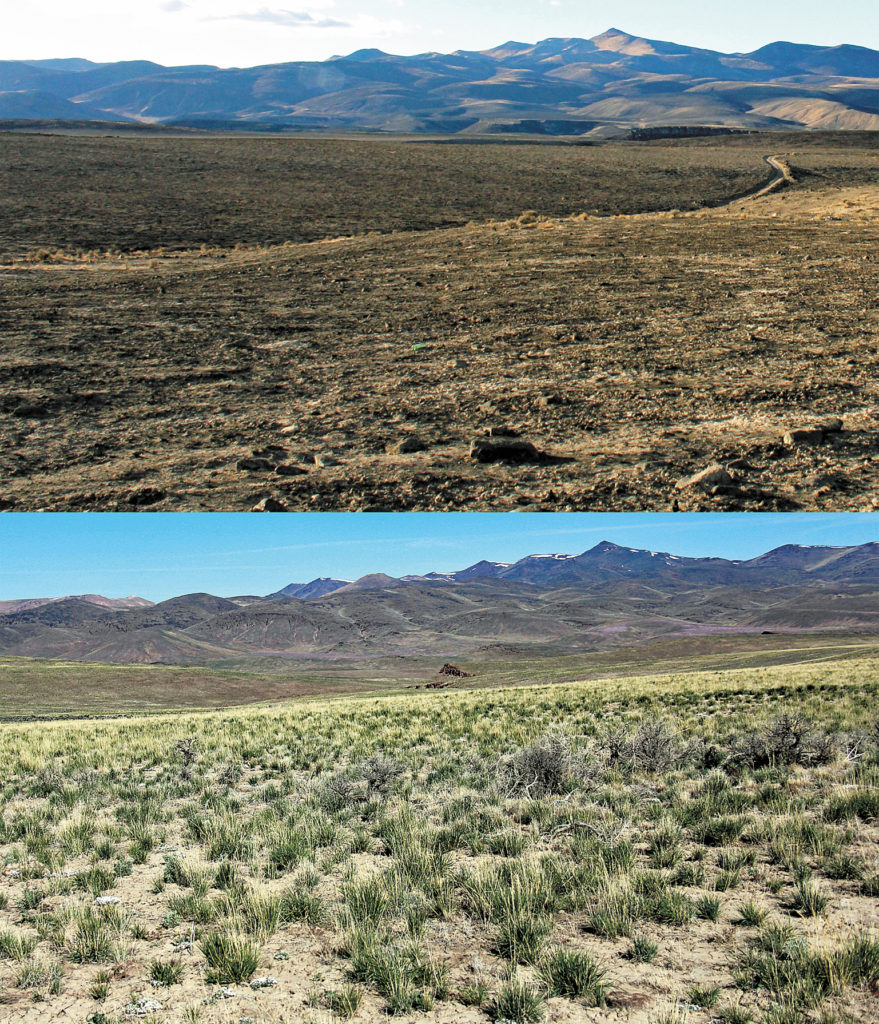
Figure 5 A-top: Burned habitat shortly following the 2018 Martin Fire (Photo taken 10-2018). B-bottom: Seeded area, 3 years after the fire. Siberian wheatgrass was the main grass species that established from all seed mixes.
The partnerships that were achieved throughout the Martin Fire restoration/rehabilitation effort were critical in the success of this wildfire rehabilitation effort and they continue to grow and prosper.
By Charlie D. Clements, Mark Freese, Caleb McAdoo and Dan Harmon
